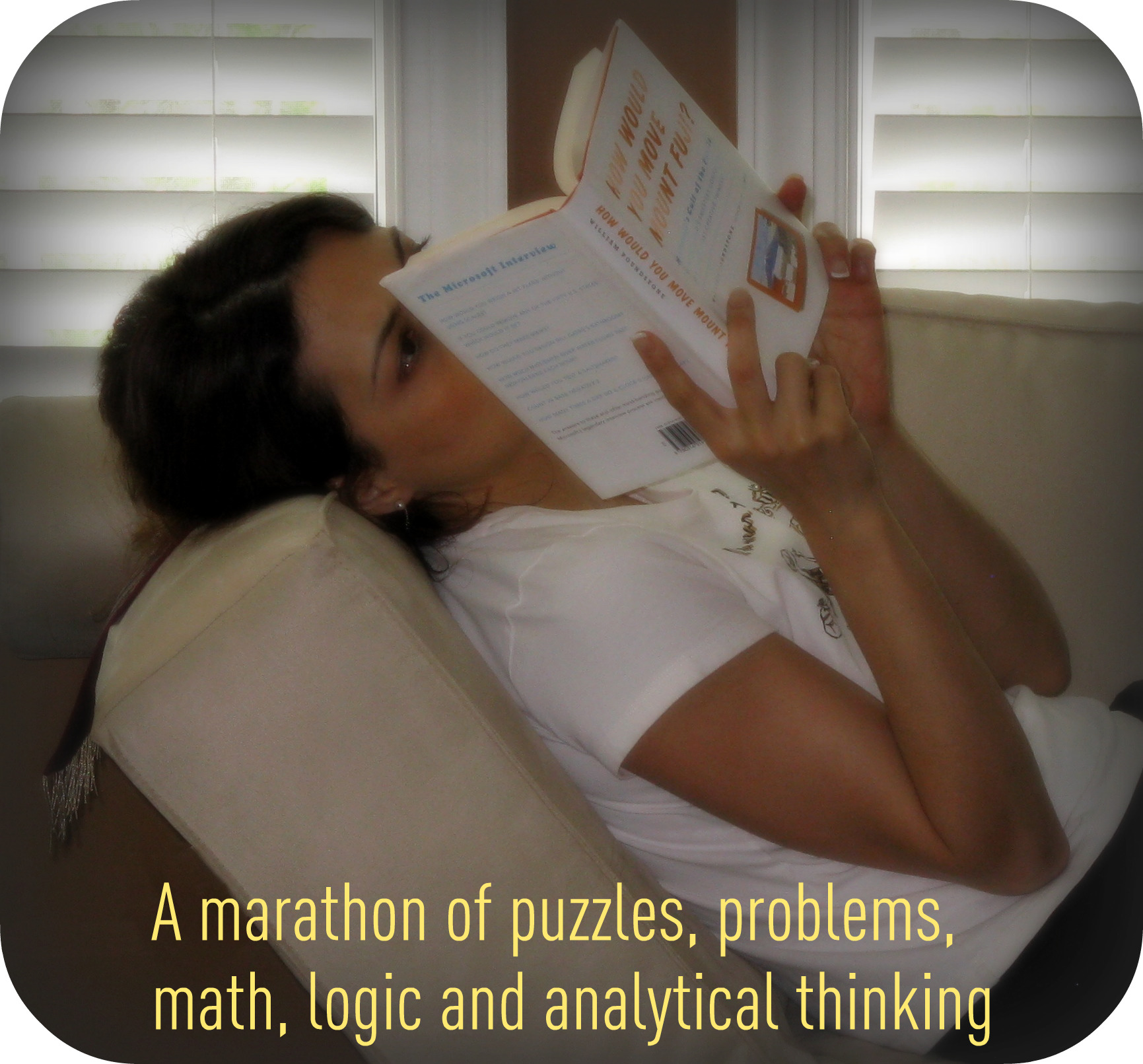Solving puzzles with Microsoft’s Cult of the Puzzle book. World’s smartest companies select the most creative thinkers.Being asked the impossible question in an already intense conversation better known as the “job interview”. I loved this book. I loved the puzzle focus, the questions, the brain teasers combined with the history of some of Silicon Valley’s greatest thinkers.
Poundstone writes well, with a mild sense of humor and good insight into the corporations which use this technique to recruit their talent. He also gives us a glimpse into how the popular IQ concept came about. For a better part of the book, he zones in the Bill Gates and Microsoft mindset, the company’s history of hiring, and stories of the those who have experienced interviews at the hands of the giant software corporation from early 1980s onward. Together, this is an excellent book to read to prepare for the ultimate techie interview or to put your brain through a serious workout, just because you can – and perhaps, once in a while, should.The book is organized in an excellent format, both for the casual reader as well as the avid puzzle solver who is measuring his or her performance or preparing for an interview. The strictly Microsoft-related chapters were decent and fun but fascinating topics came later in the book. He articulates well on the approach for thinking about the impossible puzzle, the situation which lends itself to absolutely no prospects for a solution. He takes us through ways to measure a problem in our mind first, break it down into smaller pieces and apply logic step-by-step to find a way out of the impossible scenario. What and how does a truly logical being think and analyze steps of the process in order to solve a puzzle? I marveled at the breakdown of these topics, and read most chapters more than once.
If you are reading the book for an interview in a time crunch, read Chapter 8 first. Poundstone discusses the generic puzzle solving technique and the mental preparation process you should follow after you hear or read the question. It worked well as I applied it to several puzzles in the book. Of course, lest you forget, as Poundstone put it, ‘For the purposes of a job interview, the reasoning is the “answer”.’

The author extends a helping hand to provide solid advice to companies who consider these techniques for interviews. He reminds them what to conclude and what not to conclude based on the candidate’s response, the best ways to utilize this technique in an interview and ways to win the race of seeking and securing the best talent. He particularly reminds them that while the answer to the puzzle may not be as expected, it is in their best interest to place great value in the reasoning and logical approach taken by the candidate. By the same token, if the candidate has heard of the puzzle and knows only the answer, there are ways to test further their real understanding and further measure their puzzle solving skills, as well as eliminating those who have memorized a few answers to popular puzzles.
The writing style is smooth, amusing, anecdotal and entertaining. It is an intriguing book that exercises your brain and encourages you to keep it sharp with regular exercises. The best and easiest way to do this is to solve regular puzzles. Great ideas aside, I find it challenging to see creative and flowing writing style that keeps you glued to reading abstract content – those who achieve it are gifted authors. Poundstone accomplishes this in all chapters of his book.
Reading is the best pastime for an active mind! If you like to see the other book reviews, check the index of In Print.
The last 100+ pages of the book cover detailed answers and reasoning to each of the puzzles and riddles presented throughout the book. Reading these can be tricky. If you are trying to solve the puzzle yourself, and you see the solution first, it is nearly impossible to know whether you could have solved it – or more importantly yet, if you would have followed that particular train of thought, regardless of how far you would have taken it. The puzzle is not like a math problem. You do not solve for X and stop. You must show how to derive X and why you took the path you did to solve for X as such. Once you read the solution to a puzzle, the secret is revealed and the trick is exposed, so the best approach is to try your hardest to solve the puzzle before looking at tips or solutions provided.
There are some cases where there is no singular solution. For instance, in the types of questions where you are asked to design xyz, you can exercise more freedom and especially creativity, as long as you are aware of boundaries for acceptable responses. Therefore, if you are testing your reasoning abilities, do not read the answers until you have exhausted all your options.
If you are reading for pleasure, then you may have to reference the full puzzle at the end, since Poundstone does not repeat them in the chapters, he simply references pieces of the puzzle. Being informed of all bits of data related to the puzzle are key to solve it. This caused a bit of confusion for me, since the questions are scattered in the first half of the book, and unless you recall them in detail well, you have to spend a few minutes finding the original question.
Remember, whatever you take away or learn, always stay aligned to a perfectly logical being when you want to solve a puzzle.
 I am Farnoosh, the founder of Prolific Living. So glad you are here. My mission is to empower you to unblock your creative genius to live your dream life.
I am Farnoosh, the founder of Prolific Living. So glad you are here. My mission is to empower you to unblock your creative genius to live your dream life.